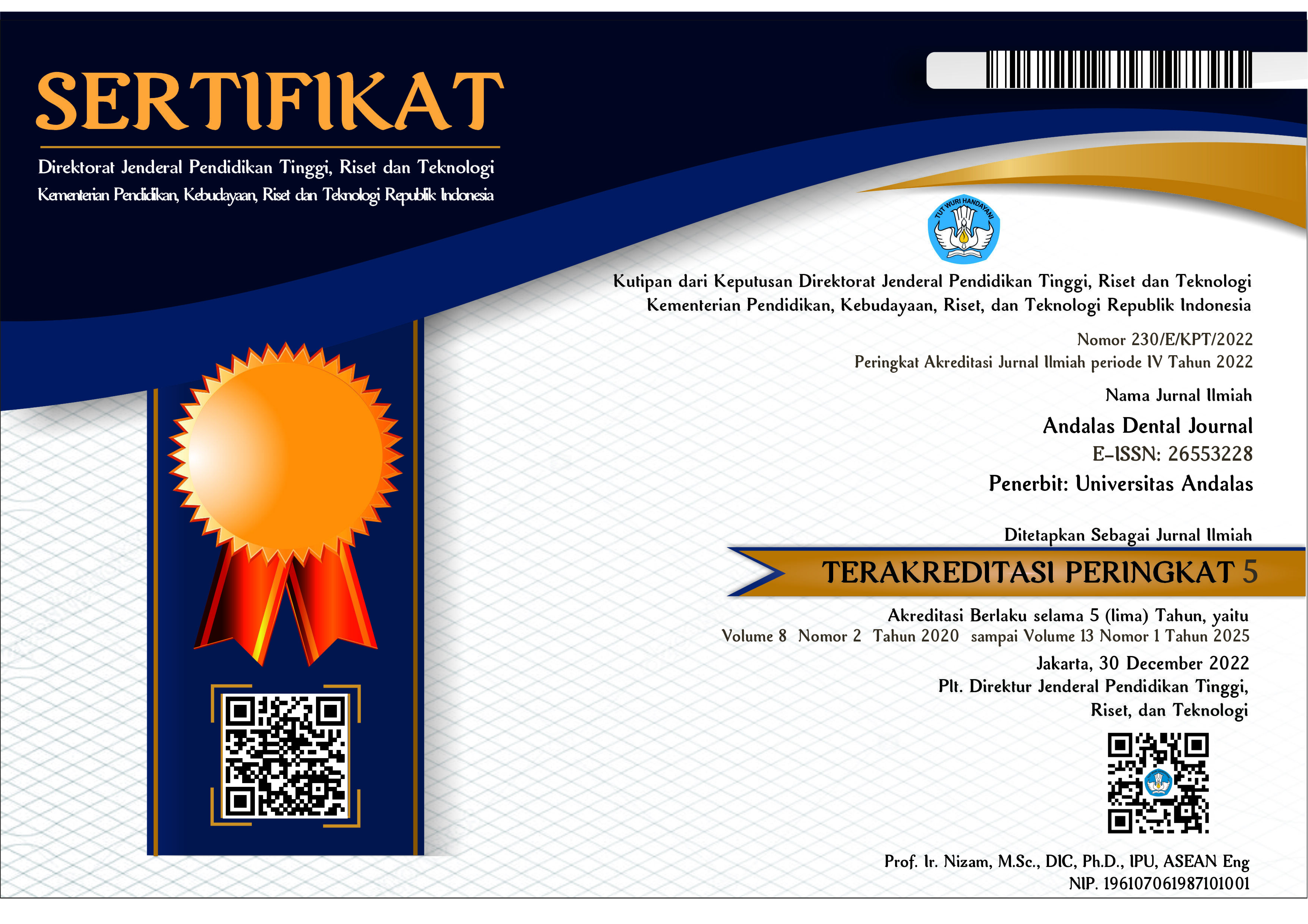Hubungan Stres dengan Temporomandibular Disorder pada Mahasiswa Fakultas Kedokteran Gigi Universitas Andalas
Abstract
Stress is the body’s response to various stressors that demand individual adjustment. College students often experience stress during their studies. Excessive stress can interfere the normal function of the body that can trigger the onset of temporomandibular disorder. The study aims to determine the relationship between stress and temporomandibular disorder in Dental Students of Andalas University. This study was observational analytic with the cross sectional design. The respondent was selected through purposive sampling technique with the total respondent were 67 students. The responden’s stress was measured with Student Stress Inventory (SSI) questionnaire, while temporomandibular disorder was examined and determined by RDC/TMD Axis I. The results showed that 37 respondents (55,2%) had mild stress and 30 respondents (44,8%) had moderate stress. The prevalence of temporomandibular disorder was 61,2%. Disc displacement with reduction was the most dominant diagnosis of temporomandibular disorder. Statistical chi-square test results obtained p=0,019 (p<0,05) that meant there was a significant relationship between stress and temporomandibular disorder in Dental Students of Andalas University. The result of this study concluded that there was relationship between stress and temporomandibular disorder.
References
2. American Psychological Association. Stress isn America: The State of Our Nation. Stress in AmericaTM Survey; 2017.
3. Folkman S. The Oxford Handbook of Stress, Health, and Coping. Oxford University Press. New York; 2011.
4. Thawabieh AM, Qaisy LM. Assessing Stress among University Students. American International Journal of Contemporary Research. 2012; 2(2): 110-116.
5. Reddy KJ. Academic Stress and Its Sources Among University Students; 2018.
6. Rahman A, Abdel G, l-Hashim BN, Al-Hiji NK, Al-Abbad Z. Stress among Medical Saudi Student at Collage of Medicine, King Faisal University. J Prev Med Hyg. 2013; 54: 195-199.
7. Basusan S, Binsanzan N, Alhasan A. Depression, Anxiety and Stress in Dental Students. International Journal of Medical Education. 2017; (8): 179-186.
8. Legiran M, Azis Z, Bellinawati N. Faktor Resiko Stres dan Perbedaannya pada Mahasiswa Berbagai Angkatan di Fakultas Kedokteran Universitas Muhammadiyah Palembang. Jurnal Kedokteran dan Kesehatan. 2015; 2(2): 197-202.
9. Condrad CD. The Handbook of Stress Neuropsyschological Effects on the Brain. Blackwell Publishing Ltd; 2011.
10. Berger M, Oleszek-Listopad J, Marczak M, Szymanska J. Psychological Aspects of Temporomandibular Disorders. Curr. Issues Pharm. Med. Sci. 2015; 28(1): 55-59.
11. Bhat S. Etiology of Temporomandibular Disorders: The journey so far. International Dentistry SA 12(4).
12. Nidal G. Concepts of TMD Etiology: Effects on Diagnosis and Treatment. Journal of Dental and Medical Sciences. 2016; 15(6): 25-42.
13. Zakrzewska JM. Orofacial Pain. Oxford University; 2009.
14. Slade GD. Epidemiology of Temporomandibular Joint Disorders and Related Painful Conditions. Molecular Pain. 2014; 10(1).
15. Wieckiewicz M, et al. Prevalence and Correlation between TMD Based on RDC/TMD Diagnoses, Oral Parafuctions and Psychoemotional Stress in Polish University Students. BioMed Research International; 2014. p. 1-7.
16. Rikmasari R, Kusumadewi A, Damayanti L, Dziab H, Kurnikasari E. The Analysis of Temporomandibular Disorder based on RDC/TMD axis I revision 2010 in Dentistry Students. Padjadjaran Journal of Dentistry. 2016; 28(2): 111-120.
17. Rokaya D, Suttagul K, Joshi S, Bhattarai BP, Shah PK, Dixit S. An Epidemiological Study on The Prevalence of Temporomandibular Disorder and Associated History and Problems in Nepalese Subjects. J Dent Anesth Pain Med. 2018; 18(1): 27-33
18. Ferreira CL, Silva MA, Felicio CM. Signs and symptoms of temporomandibular disorders in women and men. Codas. 2016; 28(1): 17-21.
19. Ahuja V, Ranjan V, Passi D, Jaiswal R. Study of stress-induced temporomandibular disorders among dental students: An institutional study. National Journal of Maxillofacial Surgery. 2018; (9): 147-154.
20. Kanehira A, Agariguchi A, Kato H, Yoshimine S, Inoue H. Association between Stress and Temporomandibular Disorder. J Jpn Prosthodont Soc. 2008;52: 375-380.
21. Saputra CM, Himawan LS, Tanti I. A Study of the Relationship Between Job Related Stress and Temporomandibular Disorders in Accountants Working in Jakarta. Journal of Dentistry Indonesia. 2016; 23(3): 69-73.
22. Desyanti A. Stres dan Temporomandibular Disorder pada Aircrew. Tesis. Spesialis dalam Ilmu Kedokteran Gigi Program Studi Ilmu Prostodonsia Universitas Indonesia. Jakarta; 2014.
23. Augusto VG, Bueno Perina KC, Gontijo Penha DS, Alves Dos Santos DC, Souza Oliver VA. Temporomandibular Dysfunction, Stress and Common Mental Disorder in University Student. Acta Ortop Bras. 2016; 24(6): 330-333.
24. Husada LE. Hubungan anatara Stres dengan Gangguan Sendi Temporomandibula pada Dokter Gigi Muda di RSGM “X”. Universitas Kristen Maranantha; 2018.
25. Arip MAS, Kamaruzaman DN, Roslan A, Ahmad A. Manual Student Stress Inventory (SSI): Development, Validity and Reability of Student Stress Inventory (SSI). Faculty of Education and Human Development Sultan Idris Education University. Malaysia; 2016.
26. Rikmasari R. Penetapan Diagnosis Gangguan Sendi Berdasarkan Research Diagnostic Criteria for Temporomandibular Joint Disorder tahun 2010. Jurnal PDGI. 2013; 2(4).
27. Yikealo D, Tareke W, Karvinen I. Stress among College Students: A Case in The Collage of Education. Open Science Journal. 2018; 3(4).
28. Alalwani BM, ALjuhani A, Fallatah SM, Abdulmajeid SA, Alsaidi DA, et al. The Prevalence of Stress among Medical Students and Its Effects on Academic Performance in The Kingdom of Saudi Arabia. The Egyptian Journal of Hospital Medicine. 2018; 71(5): 3200-3205.
29. Aser NA, Alasmari FS, Alqahtani MA, Togoo RA. Stress among Dental Students: A study in Saudi Arabia. International Journal of Scientific Study. 2018; 5(10).
30. Elias EH, Ping WS, Abdullah MC. Stress and Academic among Undergraduate Students in University Putra Malaysia. Social and Behavioral Sciences. 2011; 29: 646-655.
31. Okeson JP. Management of Temporomandibular Disorders and Occlusion. Toronto: C.V. Mosby Company; 2008.
32. Oliveira AB, de Araujo CC, Antonio TT, Folster NM, Da Silva JK. Prevalence of temporomandibular disorder and its relation with plantar pressures in university students of health-related courses. Manual Therapy, Posturology and Rehabilitation Journal; 2019.
33. Lung J, Bell L, Heslop M, Cuming S, Ariyawardana A. Prevalence of Temporomandibular disorders among a cohort of university undergraduates in Australia. J Investig Clint Dent. 2018; 9(3).
34. Liu F, Steinkeler A. Epidemiology, Diagnosis, and Treatment of Temporomandibular Disorder. Elsevier; 2013.
35. Tatli U, Machon V. Temporomandibular Joint Pathology Current Approaches; 2018.
36. Progiante PS, Patrussi MP, Lawrence HP, Goya S, Grossi PK, Grossi ML. Prevalence of Temporomandibular Disorder in Adult Brazillian Community Population Using the RDC (Axes I and II) for Temporomandibular Disorder (Maringa Study). International Journal of Prosthodonty. 2015; 28(6): 600-609.
37. Patil DJ, Dheer DS, Puri G, Konidena A, Dixit A, Gupta R. Psychological appraisal in Temporomandibular Disorder: Indian Journal of Pain. 2016; 30(1): 13-18.
38. Karthik R, Hafila MIF, Saravanan C, Vivek N, Ashwath B. Assessing Prevalence of Temporomandibular Disorder among University Student: A Questionnaire Study. J Int Soc Prev Community Dent. 2017; 7(1): 524-529.
39. Berger M, Oleszek-Listopad J, Marczak M, Szymanska J. Psychological Aspects of Temporomandibular Disorders. Curr. Issues Pharm. Med. Sci. 2015; 28(1): 55-59.
40. Navi F, Motamedi MHK, Talesh KT, Lasemi E, Nematollahi Z. Diagnosis and Management of Temporomandibular Disorder. Intech; 2013.
41. Nishio C, Tanimoto K, Hirose M, Hariuchi S, Kuroda S, et al. Stress analysis in the mandibular condyle during prolonged clenching: a theoretical approach with the finite element method. Journal Engineering in Medicine. 2008; 223(8).
42. Molina OM, Aquilino RN, Cesar EW, Curry SE, de Miranda MM. Tmj Arthralgia: a rarely described internal joint derangement and characterization regarding factors of age, pain descriptions, and prevalence. Cadernos UniFoa; 2018.
43. Kindler S, Samietz S, Houshmand M, Grahe HJ, Behardt O, et al. Deppressive and Anxiety Symptoms as a Risk Factors for temporomandibular joint pain. Journal of Pain. 2012; 13(2): 1188-1197.
Copyright (c) 2020 Zhafarina Adani Atika, Eni Rahmi, Arymbi Pujiastuty

This work is licensed under a Creative Commons Attribution-ShareAlike 4.0 International License.















